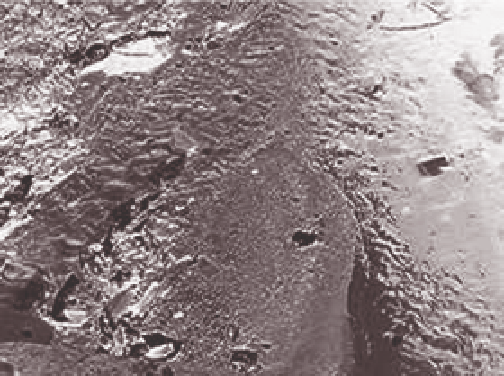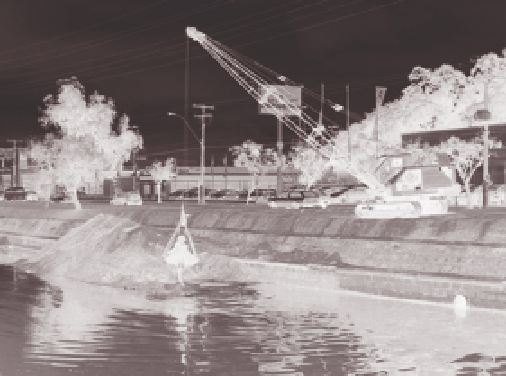Environmental Engineering Reference
In-Depth Information
(a)
(b)
Fig. 5.2
(a) Solid residues and sediments causing changes in Brazilian rivers; (b) dredging in Brazilian urban river.
fl ux of sediment reaching the world's coasts (by
1.4
and the mechanisms for transport of the pollutants
in association with them.
0.3 billion tonnes per year) because of retention
for instance within reservoirs (Syvitski
et al
. 2007),
which creates the necessity for dredging of urban
watercourses (Fig. 5.2).
In association with the movement of sediment in
urban aquatic environments are sediment (or
particulate)-associated pollutants (or PAPs), princi-
pally linked to the fi ner-particle-sized sediments (silts
and clays). Once in the river channel, PAPs can be
transported for long distances and, when present in
high concentrations, can cause serious environmen-
tal problems. Among the diverse pollutants trans-
ported in this way particularly in urban environments,
heavy metals deserve special attention because they
are not biodegradable, but are bioaccumulative, an
example of which is metallic mercury, and can cause
detrimental health effects in biota. Charlesworth
et al.
, this volume, detail the evaluation of risk that
such substances are capable of causing to those living
in urban environments.
To mitigate the effects of pollution and prevent its
distribution, and to estimate rates of transfer and the
fi nal fate of the contaminants, it is necessary to iden-
tify the sources of pollution. The fl ow of sediments
in suspension transported by a river is a mixture of
particles originating in different locations and
sources, which infl uences fi ne sediment quality and
permits an understanding of the dynamic process of
sediment transfer through the river channel. The fol-
lowing sections explore the sources of such sediment
±
5.3 The characteristics of urban
sediment
Urban sediments comprise fragments of rocks and
degraded soil produced by the processes of weather-
ing and erosion. The mineralogy of such urban sedi-
ments depends on the underlying lithology of the
urban area, and its soil type. Hence particles of
quartz, clay, and carbonates may be present, which
can form aggregates with organic matter and/or
Fe-Mn oxides, as well as anthropogenic material
including glass, that produced from industrial proc-
esses and construction waste. Hence sediments
include both minerogenic and organic particulates,
air and water, and can include biofi lms and biota
which mature to become microecosystems in their
own right (Droppo 2002). These microecosystems
are an aggregate of water, inorganic and organic
matter with functions or physical behaviors, chemi-
cal and biological autonomies, and the ability to
interact with the environment. However, the urban
environment creates a varied and complex mixture
of pollutants both intrinsic and extrinsic, which can
be both anthropogenic or natural in origin (Foster &
Charlesworth 1996; Dawson & Macklin 1998;
Singh
et al.
2005).
Fluvial sediments therefore have varying charac-
teristics due to their particle size, mineralogy, and







